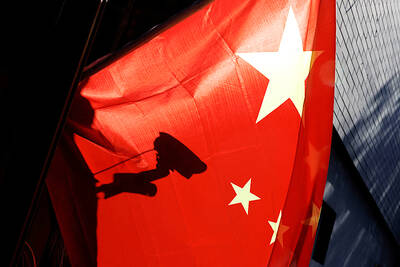The US is to send medium-range missiles including the Standard Missile 6 (SM-6) and Tomahawk to the Asia-Pacific next year to deter a Chinese attack on Taiwan, US military news Web site Defense One reported.
The report cited comments US Army General Charles Flynn made during the annual Halifax International Security Forum on Nov. 19.
“We have tested them and we have a battery or two of them today,” Flynn was quoted as saying.

Photo: Screengrab from Defense Visual Information Distribution Service’s Web site
“In [20]24. We intend to deploy that system in your region. I’m not going to say where and when. But I will just say that we will deploy them,” he said.
The US was previously prevented from deploying nuclear and conventional ground-launched ballistic missiles, cruise missiles and missile launchers with ranges of 500km to 5,500km under the terms of the Intermediate-Range Nuclear Forces Treaty.
The treaty was signed by then-US president Ronald Reagan and then-Soviet Union Communist Party general secretary Mikhail Gorbachev on Dec. 8, 1987. It was ratified on June 1, 1988.
Former US president Donald Trump announced the US’ withdrawal from the treaty on Oct. 20, 2018, citing non-compliance by Russia, due to Moscow’s development and deployment of an intermediate-range cruise missile known as the SSC-8 (Novator 9M729), as well as the need to counter a Chinese arms buildup in the Pacific.
In July, the US Marine Corps held a commissioning ceremony for the first land-based Tomahawk cruise missile battalion at the Camp Pendleton Training Center in California. The battalion is to be equipped with the Naval Strike Missile — a multi-mission cruise missile that can neutralize highly secure maritime and land targets, the US military has said.
Meanwhile, the SM-6, first commissioned in 2013, is the latest missile developed by US arms contractor Raytheon Co for its Standard Extended Range Active Missile family of missiles.
It has a top range of 240km, a flight speed of Mach 3.5 to Mach 5, and can be used as a surface-to-air missile, an anti-ballistic missile or an anti-ship missile. It has been selected by the US Army to be used as a land-based medium-range strike ballistic missile weapon system.
Flynn said with these missiles now in regular active service, the US Army has been preparing to commission the next-generation Precision Strike Missiles (PrSMs), which are under development and might be ready for service before the end of this year.
The PrSM is being developed by contractor Lockheed Martin Corp, and is to replace the MGM-140 Army Tactical Missile System.
The new missile is expected to be capable of hitting targets 499km away, farther than the SM-6’s 370km, and it can be launched from the M142 High Mobility Artillery Rocket System platform.
Flynn previously said that more regional militaries are seeking to conduct joint exercises with US forces due to China’s increasingly aggressive behavior against certain countries in the Indo-Pacific region.
China’s military is strengthening its capabilities at an accelerated rate, “so that trajectory that they’re on is a dangerous one for the region, and, candidly, it’s a dangerous moment for the world,” he said.
Meanwhile, the Pentagon on Nov. 17 said that the US Department of State has approved the potential sale of 400 Tomahawk missiles and related equipment to Japan in a deal valued at US$2.35 billion.
The package would include 400 Tomahawk missiles, 14 Tactical Tomahawk Weapon Control Systems, software, support equipment, spares and technical support, the Pentagon said.
Additional reporting by Reuters

A magnitude 7.0 earthquake struck off Yilan at 11:05pm yesterday, the Central Weather Administration (CWA) said. The epicenter was located at sea, about 32.3km east of Yilan County Hall, at a depth of 72.8km, CWA data showed There were no immediate reports of damage. The intensity of the quake, which gauges the actual effect of a seismic event, measured 4 in Yilan County area on Taiwan’s seven-tier intensity scale, the data showed. It measured 4 in other parts of eastern, northern and central Taiwan as well as Tainan, and 3 in Kaohsiung and Pingtung County, and 2 in Lienchiang and Penghu counties and 1

FOREIGN INTERFERENCE: Beijing would likely intensify public opinion warfare in next year’s local elections to prevent Lai from getting re-elected, the ‘Yomiuri Shimbun’ said Internal documents from a Chinese artificial intelligence (AI) company indicated that China has been using the technology to intervene in foreign elections, including propaganda targeting Taiwan’s local elections next year and presidential elections in 2028, a Japanese newspaper reported yesterday. The Institute of National Security of Vanderbilt University obtained nearly 400 pages of documents from GoLaxy, a company with ties to the Chinese government, and found evidence that it had apparently deployed sophisticated, AI-driven propaganda campaigns in Hong Kong and Taiwan to shape public opinion, the Yomiuri Shimbun reported. GoLaxy provides insights, situation analysis and public opinion-shaping technology by conducting network surveillance

Taiwan is gearing up to celebrate the New Year at events across the country, headlined by the annual countdown and Taipei 101 fireworks display at midnight. Many of the events are to be livesteamed online. See below for lineups and links: Taipei Taipei’s New Year’s Party 2026 is to begin at 7pm and run until 1am, with the theme “Sailing to the Future.” South Korean girl group KARA is headlining the concert at Taipei City Hall Plaza, with additional performances by Amber An (安心亞), Nick Chou (周湯豪), hip-hop trio Nine One One (玖壹壹), Bii (畢書盡), girl group Genblue (幻藍小熊) and more. The festivities are to

Auckland rang in 2026 with a downtown fireworks display launched from New Zealand’s tallest structure, Sky Tower, making it the first major city to greet the new year at a celebration dampened by rain, while crowds in Taipei braved the elements to watch Taipei 101’s display. South Pacific countries are the first to bid farewell to 2025. Clocks struck midnight in Auckland, with a population of 1.7 million, 18 hours before the famous ball was to drop in New York’s Times Square. The five-minute display involved 3,500 fireworks launched from the 240m Sky Tower. Smaller community events were canceled across New Zealand’s